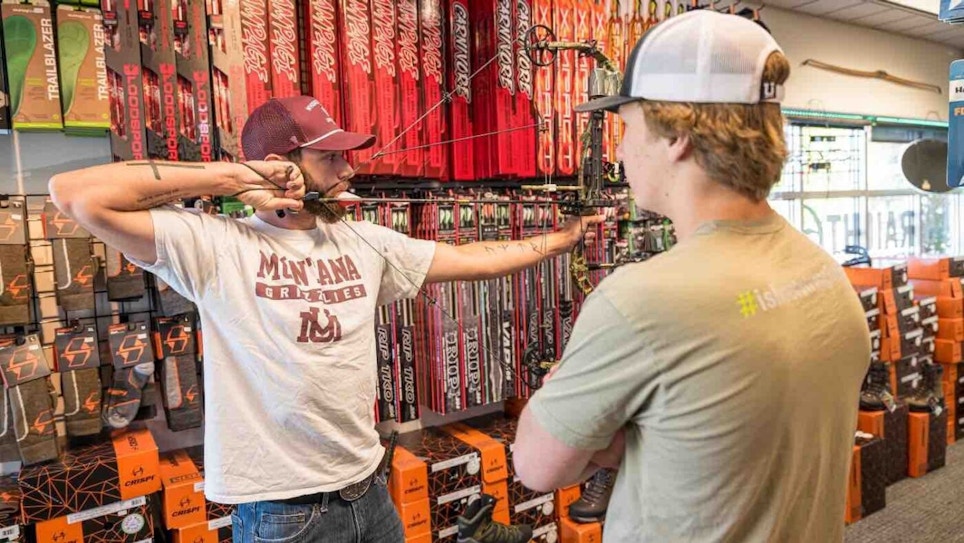Rob Morgan
Superior Archery
Billings, Montana
Like everybody, we have a draw length chart based on wingspan divided by 2.5, but that’s just our starting point. From there, we check alignment, specifically noting the elbow position (up, down, in, out). We also look at the bow arm to see if it’s overextended or crunched up. Every-one has a unique build, so the chart isn’t always 100 percent accurate, which is why it’s just our rough starting point.
I don’t find much of a difference in draw length based on release style. It’s a very small amount between a handheld and wrist-strap release. It really depends on how the individual holds the handheld release. Some hold it really deep, and some hold it closer to their fingertips. This can affect draw length to some degree.
When someone insists that their draw weight or length is a certain number but I disagree, I share my recommendations and then adjust the bow where they want it. For example, if a guy says his draw length is 29 inches, and then I tell him that he’s not a 29, but a 28, that probably won’t be very well-received. So, I set the draw weight and length where they want it. When they draw back, then I’ll offer recommendations. If they’re receptive, I’ll have them try what draw length I think they should use, but I ultimately let them decide. About 50 percent of customers go with my recommendations.
For draw weight, Mathews has the SwitchWeight mods, so ordering bows is easy. With Hoyt and Bowtech, about 90 percent of our stock flagship bows are in 70-pound peak weights. In the flagships, we stock maybe one or two 60-pounders, and if we sell one, we order another one. When it comes to women’s bows, we keep a number of 50- and 60-pounders in stock.
Marc Ridenour
Archery Central
Caldwell, Idaho
Most customers assume they need to be measured right away. I can take a rough measurement if they insist on it, but I have 30 years of experience in the archery industry, and I can estimate very close to reach a great starting point. I typically set the bow where I think it should be, and then we go back to the range and make adjustments, if needed.
If the customer has shot before, I ask what poundage they prefer. Some people think they’re like Cameron Hanes and can pull 80 pounds. However, some of them can’t even pull 70 pounds. For that reason, we like to start most customers out on the lighter side. We want them to be comfortable with shooting and not struggle.
Sometimes, customers don’t listen to suggestions. I recently worked with a customer who I suggested should shoot a 29-inch draw length, but he argued that his draw length is 30 inches. At 30 inches, the bowstring was buried into his face. It was clearly too long. Again, I said that I’d like to shorten it an inch. He denied it and said he’s been shooting 30 inches forever. Some people are just stubborn, or they fear change. There isn’t a lot you can do at that point.
As far as the most common lengths, most male customers shoot 28- or 29-inch draw lengths, but we don’t have much homework to do with that because bows have adjustable mods. Ordering in the right mix of draw weights is where we have to be careful. Sometimes we’ll stock a 60-pounder, but most bows on the shelf are 65 and 70 pounds. We occasionally sell an 80-pounder, but we don’t stock them; those are custom orders. Of course, Mathews bows are nice and easy to change with the SwitchWeight mods.
Ryan Johnson
Adrenaline Archery
Pine City, Minnesota
For draw length, we start with the customer’s wingspan divided by 2.5, and then we adjust a half-inch at a time from there to find what works for the individual customer. With draw weight, we like to start low and increase gradually. If we see the customer struggling, then we back it down a little bit.
The formula of dividing wingspan by 2.5 for draw length works about 99 percent of the time for customers shooting wrist-strap releases. Of course, the trigger position influences draw length. The forward-trigger index-finger release designs and some of the handhelds allow the customer to draw a half-inch or maybe even an inch longer than, say, with an index-finger release rigged with a standard trigger position.
I’ve learned through the years that you can’t always teach an old dog new tricks. Some customers value our suggestions regarding draw length and draw weight, while others don’t want to hear them. We give the best knowledge and expertise we can. If they take it, great; if they don’t, that’s on them. However, I’d say most of our customers are good listeners these days.
Most of the bows we keep in stock are 65-pounders straight across the board, and then we bring in some 50-pounders for women archers, who typically desire less draw weight. We keep only one or two 70-pounders on the wall of our shop. The 65-pounders cover close to 90 percent of our whitetail-hunting customers.






